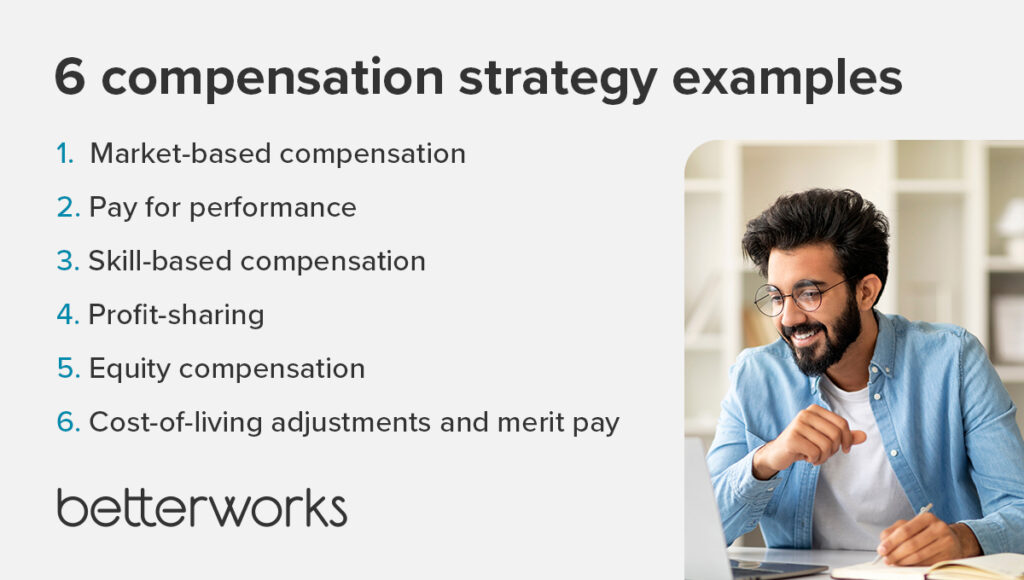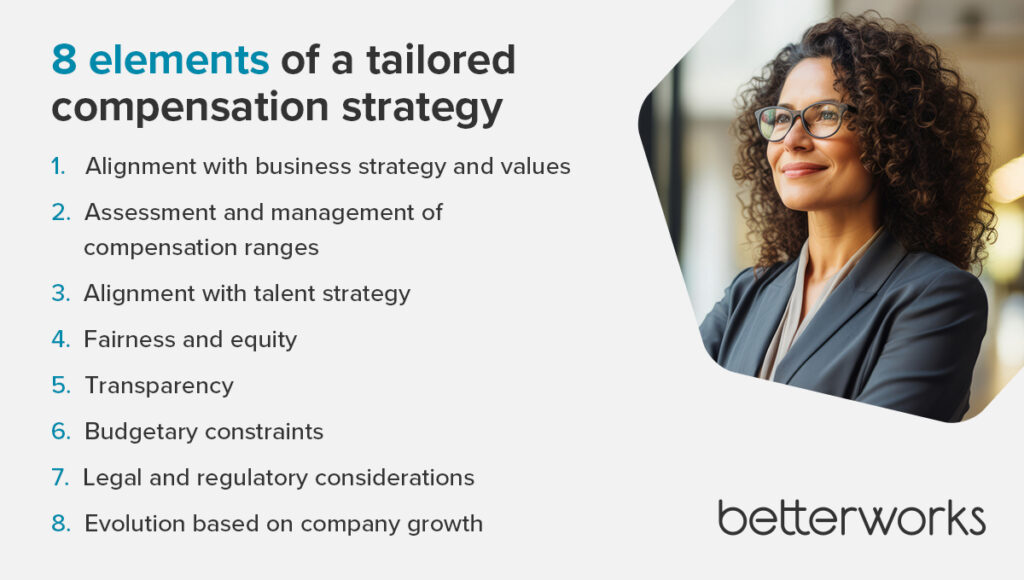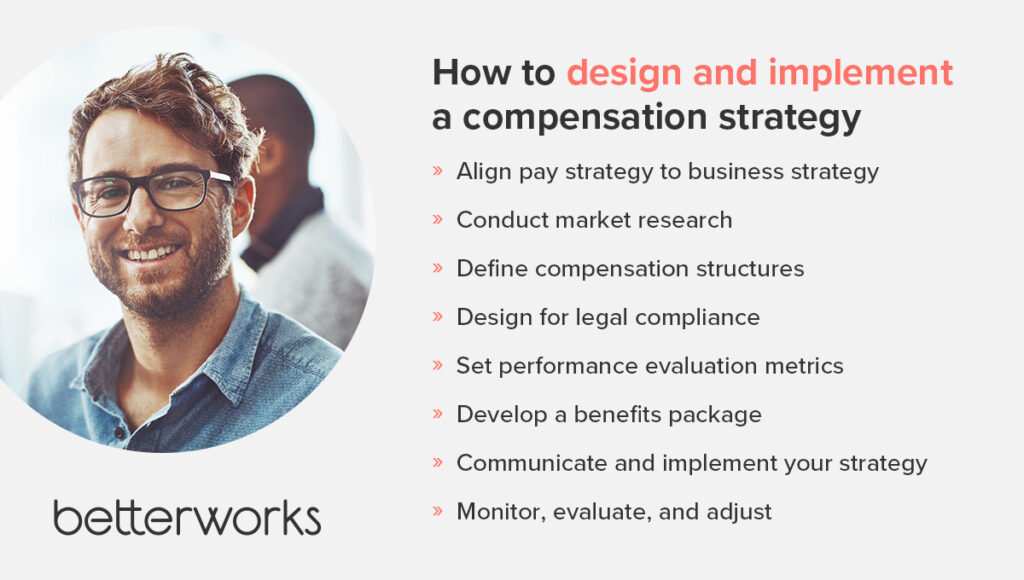Your compensation strategy is a critical component of your overall HR strategy, strongly influencing your ability to attract, motivate, and retain employees.
More than half of employers (64%) are taking proactive steps to guarantee fair pay practices, according to Payscale’s 2024 Compensation Best Practices report. And in 2024, more employers are rewarding employees for high performance and acquiring competitive skills than in 2023, signaling a shift toward more strategic and intentional compensation practices.
Organizations approach compensation in a wide variety of ways, and learning about different compensation strategy examples can help you choose the right model to support your strategic goals, drive employee satisfaction, and improve overall performance.
What is a compensation strategy?
Your compensation strategy spells out the principles you plan to follow when paying your employees in alignment with the company’s goals, competitive positioning for talent, and overall cultural values. Your strategy will drive a broad range of pay-related decisions, including cash payments, benefits, and nonmonetary compensation.
“Oftentimes, compensation decisions are made ad hoc and over time as a company grows,’ says Caitlin Collins, organizational psychologist and program strategy director at Betterworks. “ There is not a solid framework to guide decisions, but it is important to have rigor around defining compensation bands and the reasoning behind all forms of compensation. Flexibility is also important so that companies can respond to market needs.”
“Identify how your compensation strategy serves your business strategy. Is your business looking to rapidly grow, remain stable, or penetrate a new market and how does your total compensation package support that?”
caitlin collins, strategy program director, betterworks
Cash
Cash compensation, including salaries, wages, bonuses, and commissions, is the core of your company’s pay strategy. For most businesses, this represents their single greatest expense, and it’s also the major driver in conversations about pay with individual employees.
Benefits
Employee benefits include health and wellness plans, retirement savings options, and initiatives aimed at promoting a better health and work-life balance, such as free gym memberships. These components add to total compensation and support employee well-being and job satisfaction.
Non-monetary compensation
Compensation extends beyond cash and equivalents. Non-monetary compensation, such as career development opportunities, recognition programs, and a supportive work environment, play a crucial role in employee satisfaction and retention. These aspects can significantly impact an employee’s decision to stay with an organization long-term.
Compensation strategy examples: 6 different ways to approach pay
Businesses adopt diverse strategies to align pay structures with their top-level goals, organizational culture, and the competitive market environment. These strategies not only aim to attract and retain talent but also motivate employees towards higher performance.
Let’s explore six compensation strategy examples, each offering a different approach to structuring pay and benefits to meet the specific needs of both the organization and its workforce.
Market-based compensation
A market-based compensation strategy sets salaries based on what other businesses are paying for similar roles in the same industry and geographic area. This approach ensures competitiveness and fairness, attracting skilled professionals by offering compensation that reflects the rates available elsewhere.
Some employers take it a step further. Paying employees above their market value is a deliberate choice many companies make to attract high-quality talent. For instance, a tech company might regularly analyze salary surveys and industry reports to adjust its pay scales. Company leaders decide to pay employees at the 75th percentile compared to other firms in the region, making it an attractive employer for skilled professionals.
“Some companies pay above market rate as a retention and attraction strategy,” says Caitlin Collins, program strategy director at Betterworks. “Pay is one part of total compensation and companies should consider other perks that would incentivize and meet the diverse needs of employees, such as company stock, generous or unlimited paid time off, generous insurance benefits and 401k matching, and flexible working.”
Pay for performance
A pay-for-performance strategy ties employee compensation directly to performance levels, often through bonuses, commissions, or other financial incentives. This model motivates employees to excel in their roles, as their financial rewards are directly linked to their contributions to the company’s success.
In many cases, pay for performance is role-based, and requires employees in those roles to achieve a high level of performance to offset a low base salary. For example, a sales organization may offer commissions or bonuses to salespeople who exceed their quarterly sales targets, directly linking compensation to individual output and success.
Organizations need to be clear on what they base their decision on,” Caitlin explains. ” What key performance indicators (KPIs) are being measured? Do the top 10% receive these? The system has to be seen as fair and just by employees.”
Skill-based compensation
Skill-based pay rewards employees for the range and depth of their skills and competencies, rather than their job title or position. A skill-based performance strategy encourages ongoing learning and development, as employees are incentivized to acquire new skills that can lead to higher pay.
For instance, a software development firm might increase the salary of developers as they achieve certifications in new programming languages or technologies, incentivizing continuous learning and adaptation to emerging trends.
“With skills as the new currency of work, it’s critical that organizations move beyond the identification and evaluation of skills to embedding skills development into performance plans and empowering managers to coach their employees, “ Caitlin says. “This is where modern performance management systems offer a distinct advantage. Managers and employees work together to identify the skills most useful to the business in the employee’s role, make the development of those skills an integral part of a performance plan, and then provide a framework for ensuring that the skills are properly developed and leveraged by the employee.”
Profit-sharing
Profit-sharing involves distributing a portion of the company’s profits to employees, linking their compensation to the organization’s success. This approach fosters a sense of ownership among employees, aligning their interests with the company’s goals and encouraging teamwork and collaboration.
For example, a manufacturing company might distribute an annual bonus to all employees, calculated as a percentage of the net profits for the year, thereby fostering a sense of ownership and aligning individual efforts with the company’s profitability.
“Part of the goal of profit-sharing — and this is true for merit increases, too — is to enable companies to reinforce their values by rewarding collaborative actions that reflect those values,” Caitlin says.
Equity compensation
Equity compensation offers employees a share of the company’s equity, such as stock options or restricted stock units (RSUs). This long-term incentive plan is often used by startups and growth-stage companies, which often lack the cash flow necessary for standard compensation practices. Additionally, equity compensation aligns employees’ interests with the success of the business and provides the potential for significant financial rewards as the company grows.
Cost-of-living adjustments and merit pay
Combining cost-of-living adjustments (COLA) with merit pay allows businesses to address inflation and individual performance. COLA ensures that employees’ salaries keep pace with inflation, while merit pay rewards exceptional performance, providing a balanced approach to compensation that addresses both external economic factors and internal achievements.
For example, a corporation may automatically adjust salaries annually based on the local cost of living increase, and also provide merit increases to employees who exceed their performance targets, ensuring fair compensation that rewards both loyalty and excellence.

8 elements of a tailored compensation strategy
A comprehensive compensation strategy includes elements that align with the organization’s goals and the expectations of its workforce.
Alignment with business strategy and values
A successful compensation strategy must be in sync with the company’s broader business strategy and core values. This alignment ensures that compensation practices reinforce the company’s mission and objectives, encouraging behaviors that drive the organization forward.
Assessment and management of compensation ranges
Managing pay ranges meticulously ensures that salaries remain competitive and equitable. This vigilance prevents pay compression and ensures that the organization keeps pace with market trends, maintaining its appeal to both current and prospective employees.
Alignment with talent strategy
Compensation is a key driver of strategic talent outcomes. “Identify how your compensation strategy serves your business strategy,” Caitlin says. “Is your business looking to rapidly grow, remain stable, or penetrate a new market and how does your total compensation package support that?”
Identify skill and talent gaps required to achieve tomorrow’s business objectives and incentivize filling those gaps through employee development and/or talent attraction. Consistently and regularly review your compensation and talent strategies to ensure they align with each other and with the changing needs and objectives of the business. This approach affects an organization’s ability to retain top talent, making compensation a key player in the battle for skilled employees.
Fairness and equity
The drive for fairness and equity in compensation is fundamental. “Not only does a compensation strategy need to adhere to local and government laws around equal pay for equal work but it should also be transparent and well understood by employees. When employees view compensation as a ‘black box,’ it creates barriers because they may focus on whether they’re being treated fairly instead of focusing on their potential growth and development.
“Consider whether you are paying people fairly within what the market demands,” Caitlin says. Additionally, this practice supports diversity, equity, and inclusion efforts and builds trust within the workforce, as employees feel confident that their compensation reflects their value to the organization without bias.
Transparency
Transparency in compensation practices fosters an environment of trust and openness. By demystifying compensation, organizations can empower employees with the knowledge of how pay decisions are made, enhancing employee satisfaction and engagement.
Budgetary constraints
When designing your compensation strategy, consider your specific business circumstances. Acknowledging and navigating budgetary constraints is crucial, especially for smaller or growing companies. Take a pragmatic approach to compensation that considers financial limitations to scaling your program and promoting sustainable growth.
Legal and regulatory considerations
Legal and regulatory frameworks can significantly influence compensation strategies, from minimum wage requirements to evolving pay equity and transparency laws. In the state of California, you have to turn in an audit where you show pay equity. Compliance with these legal requirements not only avoids penalties but also reinforces the organization’s commitment to fairness and equity.
Evolution based on company growth
Every business will grow and change over time, and so should your compensation strategy. By adapting compensation practices as your company progresses, you can ensure that the strategy remains relevant and effective in attracting and retaining the talent you need to grow.

How to design and implement your compensation strategy
By following these steps, you can create a compensation strategy that not only attracts the talent you need but also motivates employees to contribute their best towards the company’s success.
Align pay strategy to business strategy
Make sure your pay plan helps your company achieve its big-picture goals. Think about what you want to accomplish as a business, and design your pay system to encourage the behaviors that will get you there. For example, if innovation is key to your business, consider bonuses for creative ideas.
Conduct market research
Look into what other companies in your industry are paying their employees. Use surveys and reports to get an idea of the going rates for different jobs. This will help you set competitive salaries that attract the right talent without overspending.
Define compensation structures
Create clear rules for how much you pay for different jobs within your company. This includes deciding on base salaries, and when and how employees can earn more through bonuses or stock options. Make sure these pay ranges are fair and match the job’s importance and the employee’s skills.
Design for legal compliance
Stay up-to-date on laws about pay and working hours. Follow rules about minimum wage, overtime, and equal pay for equal work. Following the law avoids fines and helps your employees feel they’re treated fairly.
Set performance evaluation metrics
Decide how you’ll measure success in your company, such as sales targets for a salesperson or project deadlines for a developer. Clear goals help employees understand what’s expected of them and how they can grow their paychecks by helping the company succeed.
Develop a benefits package
Think beyond just salaries. Offer benefits like health insurance, retirement plans, college loan repayment assistance, or flexible working hours. These extras can make a big difference in attracting and keeping employees happy and healthy, which is good for your business in the long run.
Communicate and implement your strategy
Talk openly with your employees about how the compensation system works. Explain why you’ve chosen this strategy and how it benefits both the company and them. When rolling out changes, consider doing it in stages to make the transition smoother and to get feedback at each step.
Monitor, evaluate, and adjust
Keep an eye on how well your compensation strategy is working. Are you attracting and keeping the talent you need? Are your employees motivated and hitting their targets? Be ready to tweak your strategy based on what you find and any changes in your business or the market.

Elevate your compensation strategy
As businesses continue to navigate the complexities of the modern work environment, the lessons drawn from these diverse compensation strategy examples offer a roadmap for creating more cohesive, motivated, and high-performing teams. By placing employee well-being and organizational values at the heart of compensation planning, companies can cultivate a work environment that not only meets the immediate needs of their employees but also supports long-term sustainability and growth.
In this dynamic interplay between strategy and compensation, the ultimate goal remains clear: to build a thriving, resilient organization where both the company and its employees can achieve their fullest potential.
Want to learn more? Discover 5 ways compensation practices harm your employees and company.


